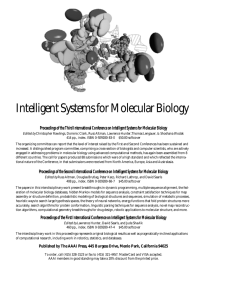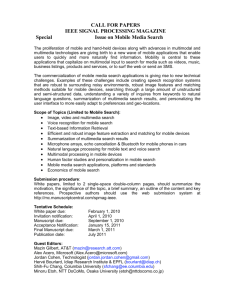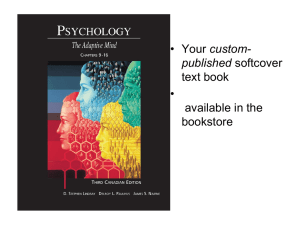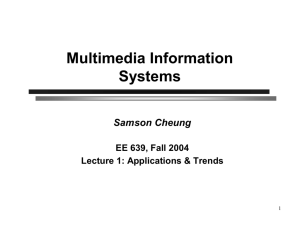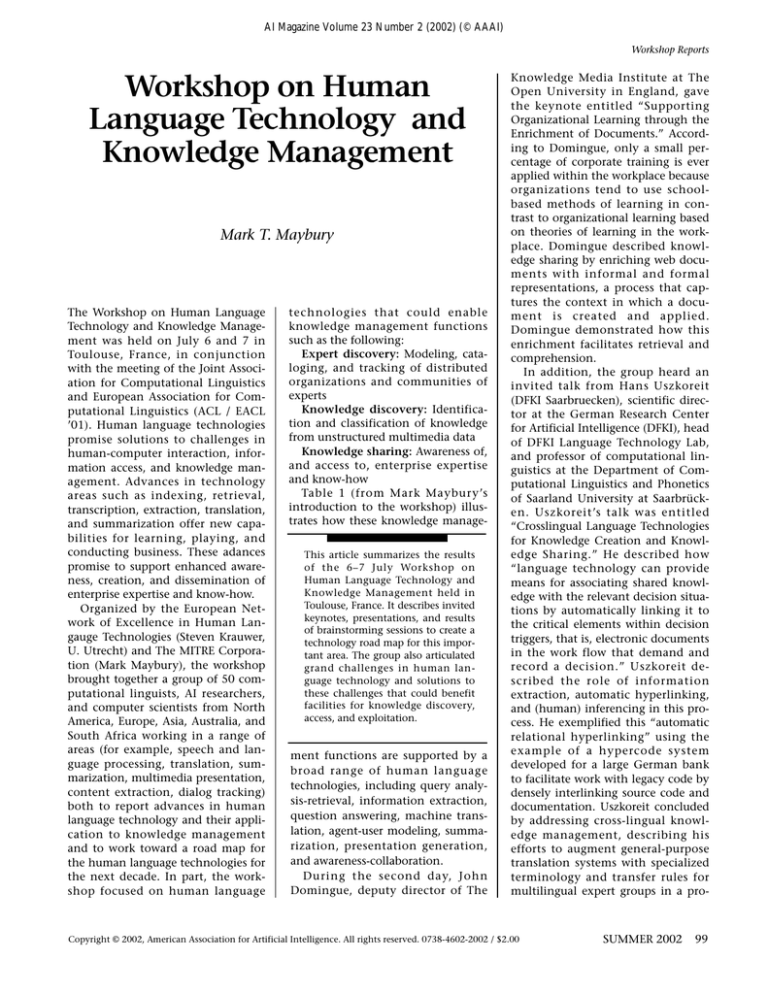
AI Magazine Volume 23 Number 2 (2002) (© AAAI)
Workshop Reports
Workshop on Human
Language Technology and
Knowledge Management
Mark T. Maybury
The Workshop on Human Language
Technology and Knowledge Management was held on July 6 and 7 in
Toulouse, France, in conjunction
with the meeting of the Joint Association for Computational Linguistics
and European Association for Computational Linguistics (ACL / EACL
’01). Human language technologies
promise solutions to challenges in
human-computer interaction, information access, and knowledge management. Advances in technology
areas such as indexing, retrieval,
transcription, extraction, translation,
and summarization offer new capabilities for learning, playing, and
conducting business. These adances
promise to support enhanced awareness, creation, and dissemination of
enterprise expertise and know-how.
Organized by the European Network of Excellence in Human Langauge Technologies (Steven Krauwer,
U. Utrecht) and The MITRE Corporation (Mark Maybury), the workshop
brought together a group of 50 computational linguists, AI researchers,
and computer scientists from North
America, Europe, Asia, Australia, and
South Africa working in a range of
areas (for example, speech and language processing, translation, summarization, multimedia presentation,
content extraction, dialog tracking)
both to report advances in human
language technology and their application to knowledge management
and to work toward a road map for
the human language technologies for
the next decade. In part, the workshop focused on human language
technologies that could enable
knowledge management functions
such as the following:
Expert discovery: Modeling, cataloging, and tracking of distributed
organizations and communities of
experts
Knowledge discovery: Identification and classification of knowledge
from unstructured multimedia data
Knowledge sharing: Awareness of,
and access to, enterprise expertise
and know-how
Table 1 (from Mark Maybury’s
introduction to the workshop) illustrates how these knowledge manageThis article summarizes the results
of the 6–7 July Workshop on
Human Language Technology and
Knowledge Management held in
Toulouse, France. It describes invited
keynotes, presentations, and results
of brainstorming sessions to create a
technology road map for this important area. The group also articulated
grand challenges in human language technology and solutions to
these challenges that could benefit
facilities for knowledge discovery,
access, and exploitation.
ment functions are supported by a
broad range of human language
technologies, including query analysis-retrieval, information extraction,
question answering, machine translation, agent-user modeling, summarization, presentation generation,
and awareness-collaboration.
During the second day, John
Domingue, deputy director of The
Knowledge Media Institute at The
Open University in England, gave
the keynote entitled “Supporting
Organizational Learning through the
Enrichment of Documents.” According to Domingue, only a small percentage of corporate training is ever
applied within the workplace because
organizations tend to use schoolbased methods of learning in contrast to organizational learning based
on theories of learning in the workplace. Domingue described knowledge sharing by enriching web documents with informal and formal
representations, a process that captures the context in which a document is created and applied.
Domingue demonstrated how this
enrichment facilitates retrieval and
comprehension.
In addition, the group heard an
invited talk from Hans Uszkoreit
(DFKI Saarbruecken), scientific director at the German Research Center
for Artificial Intelligence (DFKI), head
of DFKI Language Technology Lab,
and professor of computational linguistics at the Department of Computational Linguistics and Phonetics
of Saarland University at Saarbrücken. Uszkoreit’s talk was entitled
“Crosslingual Language Technologies
for Knowledge Creation and Knowledge Sharing.” He described how
“language technology can provide
means for associating shared knowledge with the relevant decision situations by automatically linking it to
the critical elements within decision
triggers, that is, electronic documents
in the work flow that demand and
record a decision.” Uszkoreit described the role of information
extraction, automatic hyperlinking,
and (human) inferencing in this process. He exemplified this “automatic
relational hyperlinking” using the
example of a hypercode system
developed for a large German bank
to facilitate work with legacy code by
densely interlinking source code and
documentation. Uszkoreit concluded
by addressing cross-lingual knowledge management, describing his
efforts to augment general-purpose
translation systems with specialized
terminology and transfer rules for
multilingual expert groups in a pro-
Copyright © 2002, American Association for Artificial Intelligence. All rights reserved. 0738-4602-2002 / $2.00
SUMMER 2002
99
Workshop Reports
Human Language
Technology
Grand Challenges
Benefits to Knowledge Discovery,
Access, Exploitation
Input or Query
Analysis
Interpretation of imprecise, ambiguous, or
partial multimodal input. Facilities include
spoken query processing, visual query
analysis (e.g., sketching), and mixed-media
query (e.g., text and graphics).
Natural (written, spoken, gestural) access to
information and knowledge. Decrease in access
complexity or user training. Broaden availability of
knowledge to users.
Retrieval
Natural language processing of queries and
documents. Content-based retrieval of text,
imagery, audio, video.
Enhancements to document-retrieval precision and
recall. Direct access to media, easing navigational
burden of user. Reduction of search time.
Extraction
Segmentation, object and event
identification, and extraction from
multimedia sources (text, audio, video).
Direct access to information or knowledge elements,
including specific types that might be user preferred.
Reuse of media elements enabling user-tailored
selection or presentations.
Question Answering
Question analysis, response discovery and
generation from heterogeneous sources (e.g.,
multilingual; multimedia; unstructured,
structured, semistructured)
Overcome time, memory, or attention limitations
required to sift through many returned web pages
from a traditional search by providing direct answers
to questions.
Translation
Rapid creation of translingual corpora.
Effective translingual retrieval,
summarization, and translation. Access
verbalization of graphics, visualization of
text.
Cross media-mode information and knowledge access
enabling broader access to global information sources
using methods such as translingual information
retrieval.
Dialogue
Management
Mixed-initiative natural interaction that
deals robustly with context shift,
interruptions, feedback, and shift of locus of
control.
Ability to tailor flow and control of interactions and
facilitate interactions. Includes error detection and
correction tailored to individual physical, perceptual,
and cognitive differences. Motivational and engaging
lifelike agents.
Agent or User
Modeling
Unobtrusive learning; representation; and
use of characteristics, beliefs, goals, and
plans of agents (including the user).
Enables tracking of user characteristics, skills, and
goals to enhance interaction as well as discovery of
experts by other users or agents.
Summarization
Scaleability, cross-linguality, multimedia
summarization.
Increasing speed of reviewing materials. Multimedia
summarization, cross-lingual summarization, large
multidocument summarization.
Presentation
Generation
Automated generation of coordinated
speech, natural language, gesture, animation,
nonspeech audio, generation, possibly
delivered via interactive, animated lifelike
agents (includes challenges of media
selection, allocation, coordination, and
realization)
Mixed media (e.g., text, graphics, video, speech, and
nonspeech audio) and mode (e.g., linguistic, visual,
auditory) displays tailored to the user and context.
Agents engaging and motivating to younge or less
experienced users.
Awareness and
Collaboration
Topic detection and tracking, place-based
asynchronous and synchronous
collaboration environments.
Enhance awareness of new knowledge, as well as other
user’s interests and expertise, and the ability of experts
to exchange or integrate knowledge.
Table 1. Human Language Technology for Knowledge Management.
ject for a large multinational automobile manufacturer.
A poster session included system
demonstrations and offered participants an opportunity for rich dialogue and interaction. Major papers
100
AI MAGAZINE
sessions were held in ontology construction, question answering, summarization, multilingual processing,
multimedia processing, and dialogue.
Group brainstorming sessions followed each major technology theme,
focusing on construction of a road
map. During these sessions, the
group focused on an analysis of the
present situation, a vision of where
we want to be in the future, and a
number of intermediate milestones
Workshop Reports
that would help in setting intermediate goals and measuring our progress
toward our goals.
The group outlined key challenges
and promising solutions in the areas
of ontology, summarization, multilingual processing, and multimedia
processing. With respect to ontologies, the group emphasized the need
for tools and tasks that were reusable
across domains to create and populate ontologies; the importance of a
user-centered process view; the need
to integrate shallow and deep methods; the need to collaborate with
domain ontology creators; and the
need to address ontology quality,
ambiguity, and usability (for example, using tools for structuring, integrating, visualizing, and accessing
massive or heterogeneous ontologies). The group highlighted the
promise of the semantic web, the
importance of information extraction
“plug-ins,” the possibility of organizing massive documents using
domain-specific ontologies, the
opportunity to use a “top” or core
ontology to bootstrap new domains,
the value of multidisciplinary collaborative teams (for example, domain
experts, linguists, knowledge engineers), the value of controlled language management, and the promise
of component-based methods to
facilitate ontology decomposition,
reuse, and life-cycle management.
With respect to summarization, the
group outlined challenges as including the appropriate level-depth of
analysis-representation (for example,
semantic relations, speech acts,
rhetorical structure), summarization
presentation-visualization, speech for
presentation of short summaries, the
appropriate use of indicative versus
informative summaries, and the need
for action-oriented summaries (for
example, executive-management
summaries). The group discussed a
range of solutions encompassing the
analysis of information, its transformation (including operations such as
selection, aggregation, abstraction),
and its presentation.
The group also identified a number
of fundamental multilingual challenges, including relations between
cultures, languages, lexical resources,
and ontologies; the importance of
domain knowledge and the adaptation-integration of semantic resources; the complexity of dealing
with one-to-one translation of even
the 200 most spoken-written languages (requiring 39,000 language
pairs); the need for large-scale, robust
natural language processing and, at
the same time, the importance of
fine-grained linguistic knowledge;
and the challenge of new application
domains such as content-driven
hypertextual authoring and crosslingual news linking.
The group identified resources (for
example, WORDNET, EURONET, application databases, text resources) as key
to advancement, the I N T E R L I N G U A
approach as promising, the importance of deeply annotated data combined with machine learning, the
promise of translation memories and
machine learning, and the possibility
of tailoring multiple ontologies to
users and their tasks.
Finally, the group turned its attention to multimedia challenges and
opportunities. Challenges include the
integration of multiple media; the
nature of processing (is it centralized
or mobile); the challenges of privacy,
security, and scalability; the importance of both remembering and forgetting information; the need for
multilingual and multisource information extraction; and the challenge
of cross-document coreference resolution. Location-based services were
highlighted as a promising future
area.
Two cross-cutting enabling
capabilities were identified for all the
addressed areas. First is the need for
(intelligent) text annotation. Second
is the need for large-scale annotated
corpora to enable automated training
and system evaluation.
ELSNET has captured the workshop
input and will continue to revise a
technology road map. A web site to
share the materials and results of the
workshop has been set up.1
Notes
1. www.elsnet.org/acl2001-hlt+km.html.
Simulating
Organizations
Computational Models of
Institutions and Groups
Edited by Michael J. Prietula,
Kathleen M. Carley, and Les Gasser
6 x 9, 350 pp., ISBN 0-262-66108-X
To order, call 800-405-1619
(http://mitpress.mit.edu)
Distributed by
The MIT Press,
5 Cambridge Center,
Cambridge, MA 02142
Mark Maybury is executive
director
of
MITRE’s Information
Technology Division in
Bedford, Massachusetts.
He is a member of the
board of directors of the
Object Management
Group, secretary-treasurer of the Association of Computing
Machinery SIGART, and a member of the
Intelligent User Interfaces Steering Council. Maybury has published over 50 technical and tutorial articles and is editor of a
number of books. Maybury received a
doctorate in AI from Cambridge University in England in 1991. Maybury is an
international adviser to the German Ministry for Education and Research.
SUMMER 2002
101
Workshop Reports
Intelligent Systems
for Molecular
Biology
ISMB-2000—San Diego, California
ISMB-96—St. Louis, Missouri
Proceedings of the Eighth International Conference
on Intelligent Systems for Molecular Biology
Proceedings of the Fourth International Conference
on Intelligent Systems for Molecular Biology
Edited by Russ Altman, Timothy Bailey, Philip Bourne, Michael Gribskov, Thomas Lengauer, Ilya Shindyalov, Lynn Ten Eyck, and Helge
Weissig
Edited by David J. States, Pankaj Agarwal, Terry Gaasterland,
Lawrence Hunter, and Randall F. Smith
ISBN 1-57735-115-0
ISBN 1-57735-002-2
274 pp., index, $65.00 softcover
436 pp., index, $65.00 softcover
ISMB-95—Cambridge, England
ISMB-99—Heidelberg, Germany
Proceedings of the Seventh International Conference on Intelligent Systems for Molecular Biology
Edited by Thomas Lengauer, Reinhard Schneider, Peer Bork, Douglas Brutlag, Janice Glasgow, Hans-Werner Mewes, and Ralf Zimmer
ISBN 1-57735-083-9
324 pp., index, $65.00 softcover
ISMB-98—Montréal, Quebec, Canada
Proceedings of the Sixth International Conference
on Intelligent Systems for Molecular Biology
Edited by Janice Glasgow, Tim Littlejohn, François Major, Richard
Lathrop, David Sankoff, and Christoph Sensen
ISBN 1-57735-053-7
234 pp., index, $65.00 softcover
ISMB-97—Halkidiki, Greece
Proceedings of the Fifth International Conference
on Intelligent Systems for Molecular Biology
Edited by Terry Gaasterland, Peter Karp, Kevin Karplus, Christos
Ouzounis, Chris Sander, and Alfonso Valencia
ISBN 1-57735-022-7
Proceedings of the Third International Conference
on Intelligent Systems for Molecular Biology
Edited by Christopher Rawlings, Dominic Clark, Russ Altman,
Lawrence Hunter, Thomas Lengauer, and Shoshana Wodak
ISBN 0-929280-83-0
427 pp., index, $65.00 softcover
ISMB-94—Stanford, California
Proceedings of the Second International Conference on Intelligent Systems for Molecular Biology
Edited by Russ Altman, Douglas Brutlag, Peter Karp, Richard Lathrop, and David Searls
ISBN 0-929280-68-7
401 pp., index, $65.00 softcover
ISMB-93—Bethesda, Maryland
Proceedings of the First International Conference
on Intelligent Systems for Molecular Biology
Edited by Lawrence Hunter, David Searls, and Jude Shavlik
ISBN 0-929280-47-4
468 pp., index, $65.00 softcover
382 pp., index, $65.00 softcover
Published by The AAAI Press, 445 Burgess Drive, Menlo Park, California 94025
To order, call (650) 328-3123 or fax to (650) 321-4457. MasterCard and VISA accepted.
102
AI MAGAZINE

